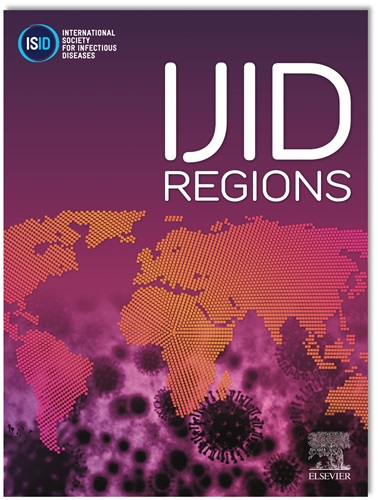马尔内菲Talaromyces marneffei感染患者骨破坏的患病率:系统回顾和荟萃分析。
IF 4.8
2区 医学
Q1 INFECTIOUS DISEASES
引用次数: 0
摘要
目的:本系统综述和荟萃分析旨在评估马尔尼菲Talaromyces marneffei感染患者骨破坏的患病率,检查骨病变的分布模式,并评估hiv阳性和hiv阴性患者之间的差异。方法:遵循PRISMA指南,对15项研究839例患者进行分析。随机效应荟萃分析用于估计患病率和优势比。采用ROBINS-I评价研究质量。结果:骨破坏的总体发生率为18% (95% CI: 10%-27%)。hiv阴性患者骨破坏的几率明显更高(OR: 0.09, 95% CI: 0.02-0.37)。骨病变分布广泛,骨性病变(45.7-71.4%)高于关节性病变(7.1-66.7%)。颅骨、肋骨和腰椎常受影响。结论:骨破坏是TM感染的重要并发症,特别是在hiv阴性患者中。不同的解剖分布强调需要对疑似病例进行全面的骨骼评估。本文章由计算机程序翻译,如有差异,请以英文原文为准。
Prevalence of bone destruction in patients with TALAROMYCES MARNEFFEI infection: A systematic review and meta-analysis
Objectives
This systematic review and meta-analysis aimed to evaluate the prevalence of bone destruction in patients with Talaromyces marneffei infection, examine distribution patterns of bone lesions, and assess differences between HIV-positive and HIV-negative patients.
Methods
Following PRISMA guidelines, 15 studies involving 839 patients were analyzed. Random-effects meta-analysis was performed to estimate prevalence and odds ratios. Study quality was assessed using ROBINS-I.
Results
The overall prevalence of bone destruction was 18% (95% CI: 10-27%). HIV-negative patients showed significantly higher odds of bone destruction (OR: 0.09, 95% CI: 0.02-0.37%). Bone lesions were widely distributed, with osseous involvement (45.7-71.4%) more prevalent than articular (7.1-66.7%). The skull, ribs, and lumbar vertebrae were commonly affected.
Conclusion
Bone destruction is a significant complication in TM infection, particularly in HIV-negative patients. The diverse anatomical distribution emphasizes the need for comprehensive skeletal assessment in suspected cases.
求助全文
通过发布文献求助,成功后即可免费获取论文全文。
去求助
来源期刊
CiteScore
18.90
自引率
2.40%
发文量
1020
审稿时长
30 days
期刊介绍:
International Journal of Infectious Diseases (IJID)
Publisher: International Society for Infectious Diseases
Publication Frequency: Monthly
Type: Peer-reviewed, Open Access
Scope:
Publishes original clinical and laboratory-based research.
Reports clinical trials, reviews, and some case reports.
Focuses on epidemiology, clinical diagnosis, treatment, and control of infectious diseases.
Emphasizes diseases common in under-resourced countries.

 求助内容:
求助内容: 应助结果提醒方式:
应助结果提醒方式:


